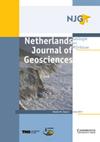A complete Late Weichselian and Holocene record of aeolian coversands, drift sands and soils forced by climate change and human impact, Ossendrecht, the Netherlands
IF 2.3
2区 地球科学
Q3 GEOSCIENCES, MULTIDISCIPLINARY
Netherlands Journal of Geosciences-Geologie En Mijnbouw
Pub Date : 2019-01-01
DOI:10.1017/njg.2019.3
引用次数: 16
Abstract
Abstract A stacked aeolian sequence with intercalated soils is presented from the southern Netherlands, which fully covers the Late Weichselian and Holocene periods. An integrated sedimentological (sedimentary structures, grain size), palynological (pollen) and dating approach (radiocarbon, optically stimulated luminescence (OSL)) was applied to unravel climatic and human forcing factors. The dating results of soils and sediments are compatible, and no large hiatuses between the radiocarbon-dated top of the soils and OSL-dated overlying sands were observed. It is argued that the peaty top of wet-type podzols can be used for reliable radiocarbon dating. This study reveals more phases than previously known of landscape stability (Usselo Soil and two podzol soils) and instability (Younger Coversand I and II, two drift-sand units) that are related to Late Weichselian climate change and Holocene human occupation. Regional aeolian deposition in source-bordering (river) dunes (Younger Coversand II) took place in the second part of the Younger Dryas, after 12.3 ka cal. BP, implying a delayed response to Younger Dryas cooling, vegetation cover decline and river pattern change of the Scheldt. The onset of podzolisation and development of ericaceous vegetation occurred prior to the introduction of Neolithic farming, which is earlier than previously assumed. Early podzolisation was followed by a short phase of local drift-sand deposition, at c.5500 cal. BP, that possibly relates to agriculture. Strong human impact on the landscape by deforestation and agriculture resulted in a second phase of widespread drift-sand deposition covering the younger podzol soil after AD 1000.在气候变化和人类影响下形成的风成覆盖地、流沙和土壤的完整晚期魏希世和全新世记录,Ossendrecht,荷兰
摘要:研究了荷兰南部一个覆盖了晚魏奇塞利世和全新世的层间土壤层叠风成层序。综合沉积学(沉积构造、粒度)、孢粉学(花粉)和测年(放射性碳、光激发发光)方法,揭示了气候和人为强迫因素。土壤和沉积物的定年结果是一致的,土壤顶部的放射性碳定年结果与上覆砂的ols定年结果之间没有明显的间断。认为湿型灰化岩的泥炭顶可以用于可靠的放射性碳定年。该研究揭示了与魏奇塞世晚期气候变化和全新世人类活动有关的景观稳定性(Usselo土和两个灰壤土)和不稳定性(Younger Coversand I和II,两个流沙单元)的更多阶段。源缘(河)沙丘(Younger Coversand II)的区域风成沉积发生在新仙女木期的第二阶段,即12.3 ka cal. BP之后,暗示了对新仙女木期降温、植被覆盖减少和斯凯尔德河格局变化的延迟响应。灰化化的开始和埃里克森植被的发展发生在新石器时代农业的引入之前,这比以前假设的要早。早期的灰化化之后是短暂的当地流沙沉积阶段,大约在5500 cal. BP,这可能与农业有关。公元1000年后,森林砍伐和农业对景观的强烈影响导致第二阶段广泛的流沙沉积覆盖了较年轻的灰化土。
本文章由计算机程序翻译,如有差异,请以英文原文为准。
求助全文
约1分钟内获得全文
求助全文
来源期刊
CiteScore
4.00
自引率
25.90%
发文量
14
审稿时长
>12 weeks
期刊介绍:
Netherlands Journal of Geosciences - Geologie en Mijnbouw is a fully open access journal which publishes papers on all aspects of geoscience, providing they are of international interest and quality. As the official publication of the ''Netherlands Journal of Geosciences'' Foundation the journal publishes new and significant research in geosciences with a regional focus on the Netherlands, the North Sea region and relevant adjacent areas. A wide range of topics within the geosciences are covered in the journal, including "geology, physical geography, geophyics, (geo-)archeology, paleontology, hydro(geo)logy, hydrocarbon exploration, modelling and visualisation."
The journal is a continuation of Geologie and Mijnbouw (published by the Royal Geological and Mining Society of the Netherlands, KNGMG) and Mededelingen Nederlands Instituut voor Toegepaste Geowetenschappen (published by TNO Geological Survey of the Netherlands). The journal is published in full colour.

 求助内容:
求助内容: 应助结果提醒方式:
应助结果提醒方式:


